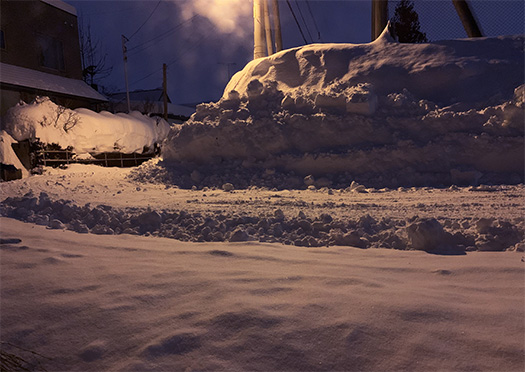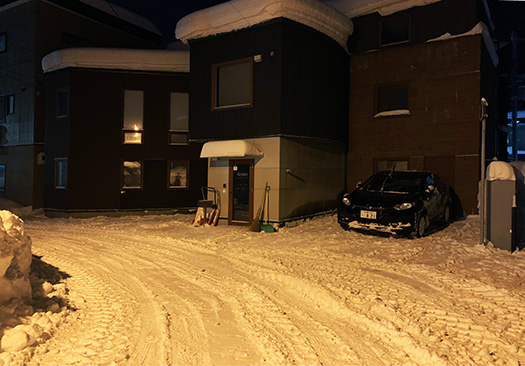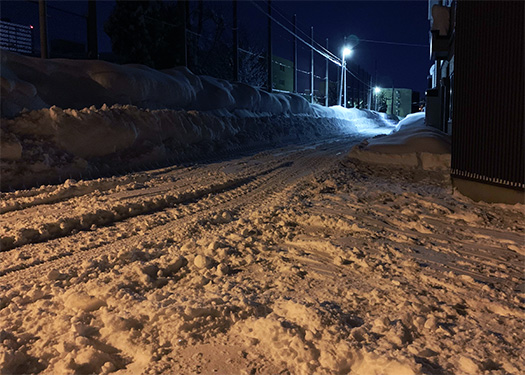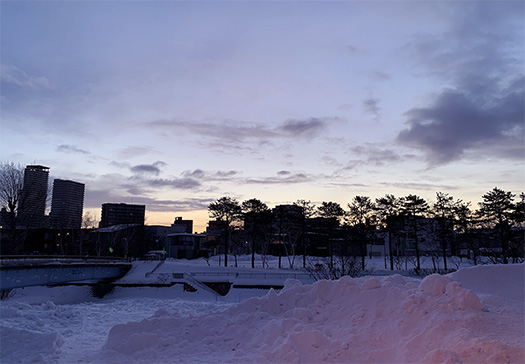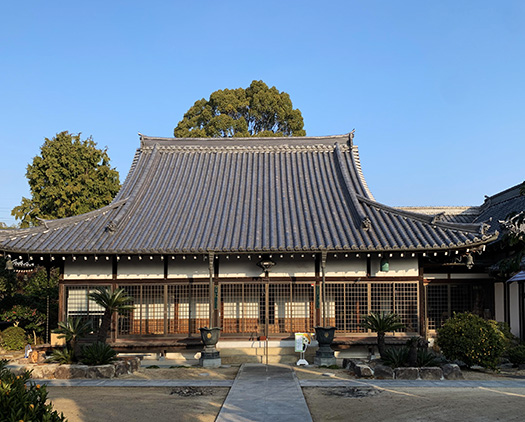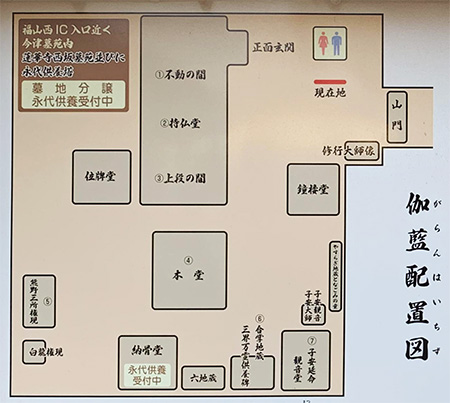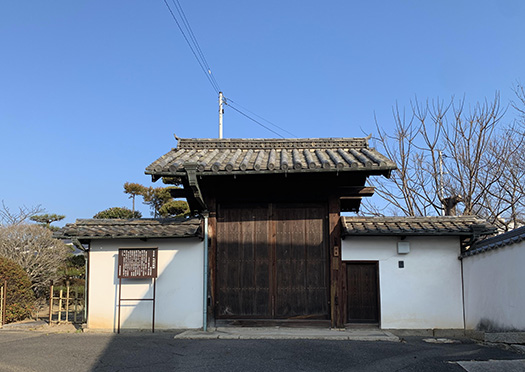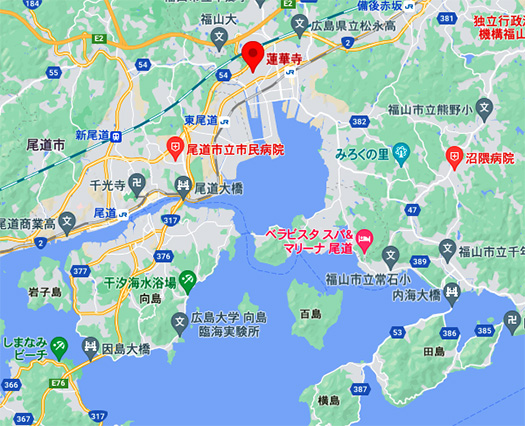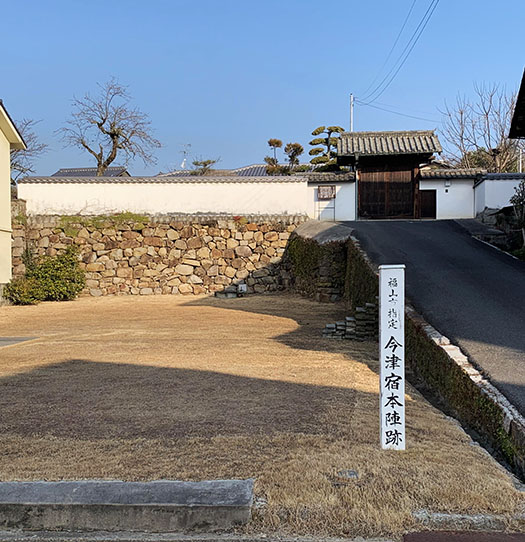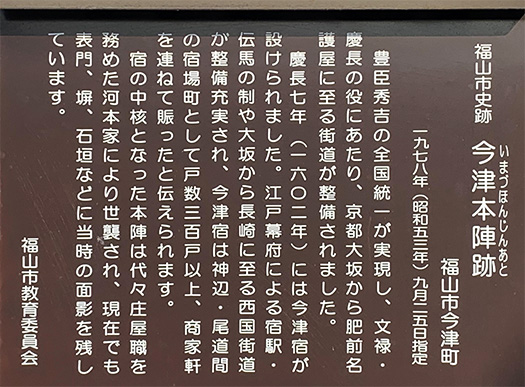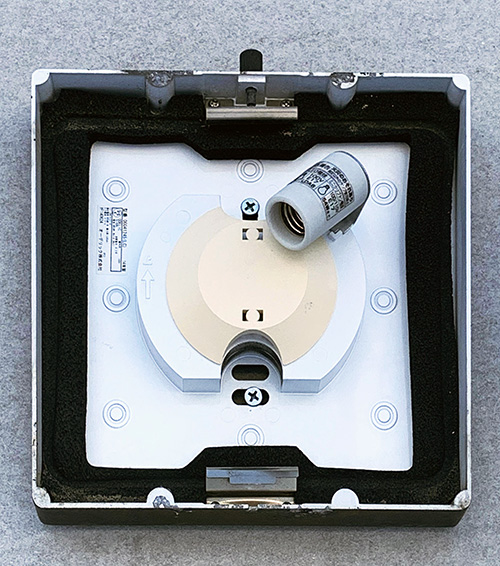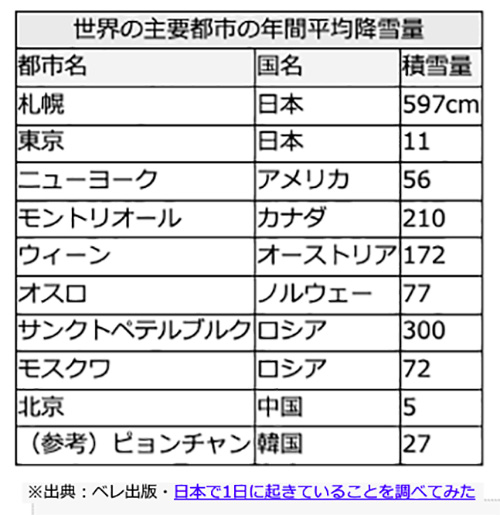
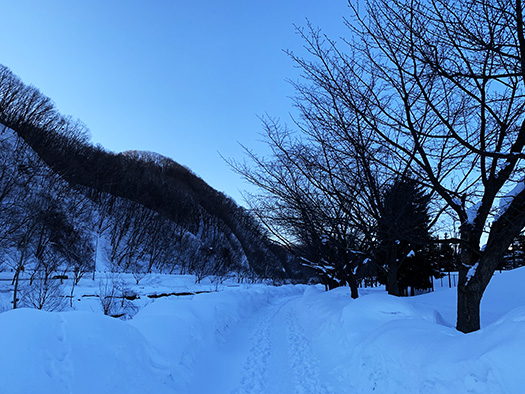
札幌は年間積雪が6m近いという稀有な地域にある大都市。
モスクワは寒いけれど、積雪はそれほどでもないと言う。
世界で最も積雪量の多い都市は札幌。人口が100万人以上いる大都市で、
年間の積雪量が500cmを超えているのは世界中で札幌だけ。
世界の主要都市の年間平均降雪量を比較しているのが上の表。
札幌のように200万人人口の地域でこれだけ積雪量が多いのは極めて異例。
豪雪地帯・札幌に200万人近い人が住める理由は公共の除雪システムのため。
札幌の雪対策の年間予算はおよそ200億円。
除雪作業で一日に活動する作業員は約3000人除雪車は1000台という規模。
翌朝の通勤通学に支障がないよう夜間に主要道路の雪かき作業を完了させる。
一晩で行われる除雪総延長は5100kmにも上る。このような世界最高レベルの
除雪システムによって豪雪地域でも200万人が活動できる大都市が機能できる。
〜以上データは、日本と世界の統計データより、要旨抜粋。
まぁ世界的にほぼ自然発生的に「条件のいい土地に人が集まる」という
与条件からまずは大都市の環境基盤があり、その上でその国ごとで
権力の複雑な争闘経緯が重なっていわゆる「大都市」が形成されていく。
そして経済発展に即して人口の集積が進んでいくということになる。
日本の場合、与条件としての国土面積が小さいということがまずある。
歴史的には北海道の開拓は明治の開国とワンセットで主に「国防」の観点から
ロシアの極東における南下侵略への強い防衛意識が高まって
積雪寒冷という厳しい条件の土地だけれど、国家の存亡を掛けて開拓してきた。
札幌がその首府として選択されたのは、北海道の中心的機能を果たすのに
地理的、気象的条件で総合的に選択された経緯がある。
江戸末期の「北辺防備」の論議でほぼ衆目の一致した開発特区だったといえる。
近代国家としてもっとも最近取り組んできた「計画都市」。
奈良、京都、江戸・東京と並んで国家の全体力を掛けた国策都市なのですね。
開拓して人間を居住させること自体が国防の最高目標だった。
札幌が日本人の意識の中である特異な部分を占めているのはこうした経緯による。
年間除雪費用が200億円規模で、人口割りすれば一人あたり10,000円。
もちろんその他にも経費は掛かるわけで市の予算は8,723億円。
除雪費用は2.3%を占める割合となります。
国策で国家経営から民間経営に移譲したJRの予算でも除雪費用は必要。
ただでさえもっとも経営売上げが小さい地域でかつ人口もまばらで
面積が広いという条件の中で経営していくのは厳しい条件だと思う。
自分だったら、その経営条件のきびしさに怖れを成すに違いない。
さて、こういう条件下ではあるけれど、
今後とも日本にとって北海道経営は不可欠なモノには違いない。
こういう与条件だから伝統的な軸組木造住宅の高断熱高気密技術も発展できた。
今後の日本全体の省エネ技術の基盤を創造できた貴重な地域。
誇りを持って、地域の危機を乗り越えていきたい。
English version⬇
[Infrastructure crisis in the world’s largest snowfall 2 million cities]
Sapporo is a large city in a rare area with an annual snowfall of nearly 6m.
Moscow is cold, but not so much snow.
Sapporo is the city with the most snow in the world. In a big city with a population of over 1 million
Sapporo is the only place in the world where the annual snowfall exceeds 500 cm.
The table above compares the average annual snowfall in major cities around the world.
In an area like Sapporo with a population of nearly 2 million, it is extremely unusual to have such a large amount of snow.
The reason why nearly 2 million people can live in Sapporo, which is a heavy snowfall area, is because of the public snow removal system.
The annual budget for snow measures in Sapporo is about 20 billion yen.
There are about 3,000 workers working on road snow removal work a day, and 1,000 snowplows.
Complete the snow shoveling work on the main road at night so as not to interfere with commuting to work or school the next morning.
The total length of snow removal that takes place overnight is said to be as high as 5100km. World’s highest level like this
The snow removal system can function in a large city where 2 million people can work even in heavy snowfall areas.
~ The above data is an excerpt from Statistical data of Japan and the world .
Well, it is said that “people gather in a land with good conditions” almost spontaneously worldwide.
From the given conditions, first of all, there is an environmental infrastructure of a big city, and then each country
The so-called “big city” is formed by overlapping the complicated struggle of power.
And the population will be concentrated in line with economic development.
In the case of Japan, the first thing is that the land area is small as a given condition.
Historically, the development of Hokkaido was a set with the opening of the Meiji era, mainly from the perspective of “national defense.”
A growing awareness of defense against the invasion of the South in Russia’s Far East
Although it is a land with severe snow and cold conditions, it has been cultivated for the survival of the nation.
Sapporo was selected as the capital city to fulfill the central function of Hokkaido.
There is a history of comprehensive selection based on geographical and meteorological conditions.
It can be said that it was a special development zone that was almost in agreement with the public in the discussion of “Northern Defense” in the late Edo period.
The “planned city” that we have been working on most recently as a modern nation.
Along with Nara, Kyoto, and Edo / Tokyo, it is a national policy city that puts the whole power of the nation.
Pioneering and inhabiting humans was the highest goal of national defense.
It is for this reason that Sapporo occupies a peculiar part of Japanese consciousness.
The annual snow removal cost is about 20 billion yen, which is 10,000 yen per person when divided by the population.
Of course, there are other expenses, so the city budget is 872.3 billion yen.
Snow removal costs account for 2.3%.
Snow removal costs are required even with the JR budget, which was transferred from national management to private management under national policy.
It is an area with the lowest management sales and a sparse population.
I think it is a strict condition to manage under the condition that the area is large.
I must be afraid of the strictness of the business conditions.
Well, under these conditions,
Hokkaido management must be an indispensable item for Japan in the future.
Because of these conditions, the highly insulated and airtight technology of traditional wooden houses with frameworks could be developed.
A valuable area that was able to create the foundation of energy-saving technology for Japan as a whole in the future.
I want to take pride in overcoming the crisis in the region.
Posted on 2月 8th, 2022 by 三木 奎吾
Filed under: 「都市の快適」研究, 住宅マーケティング | No Comments »


